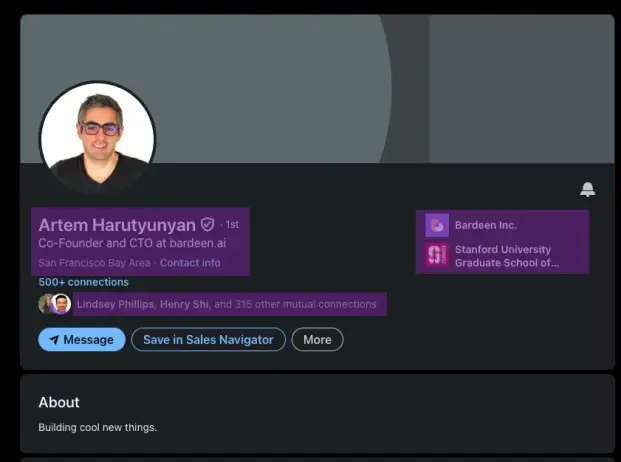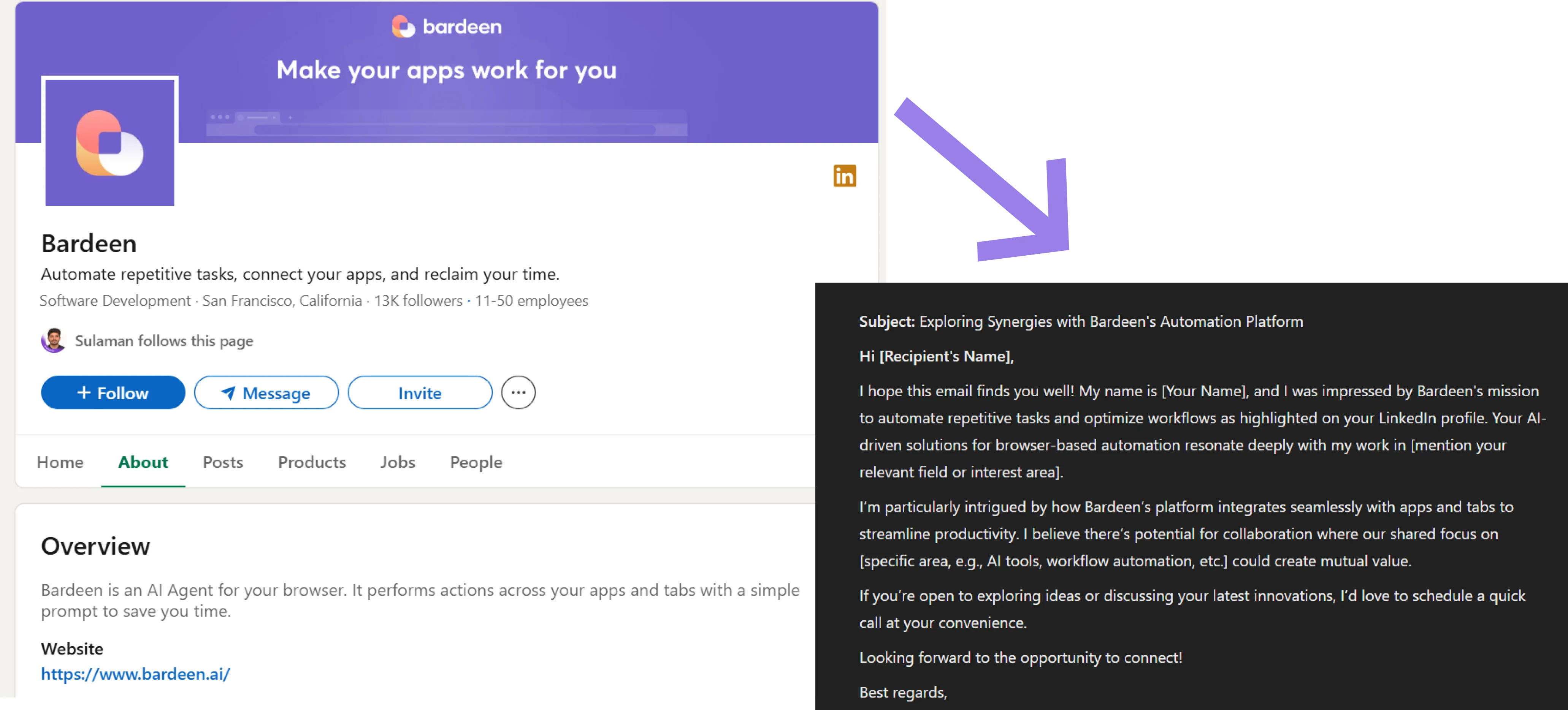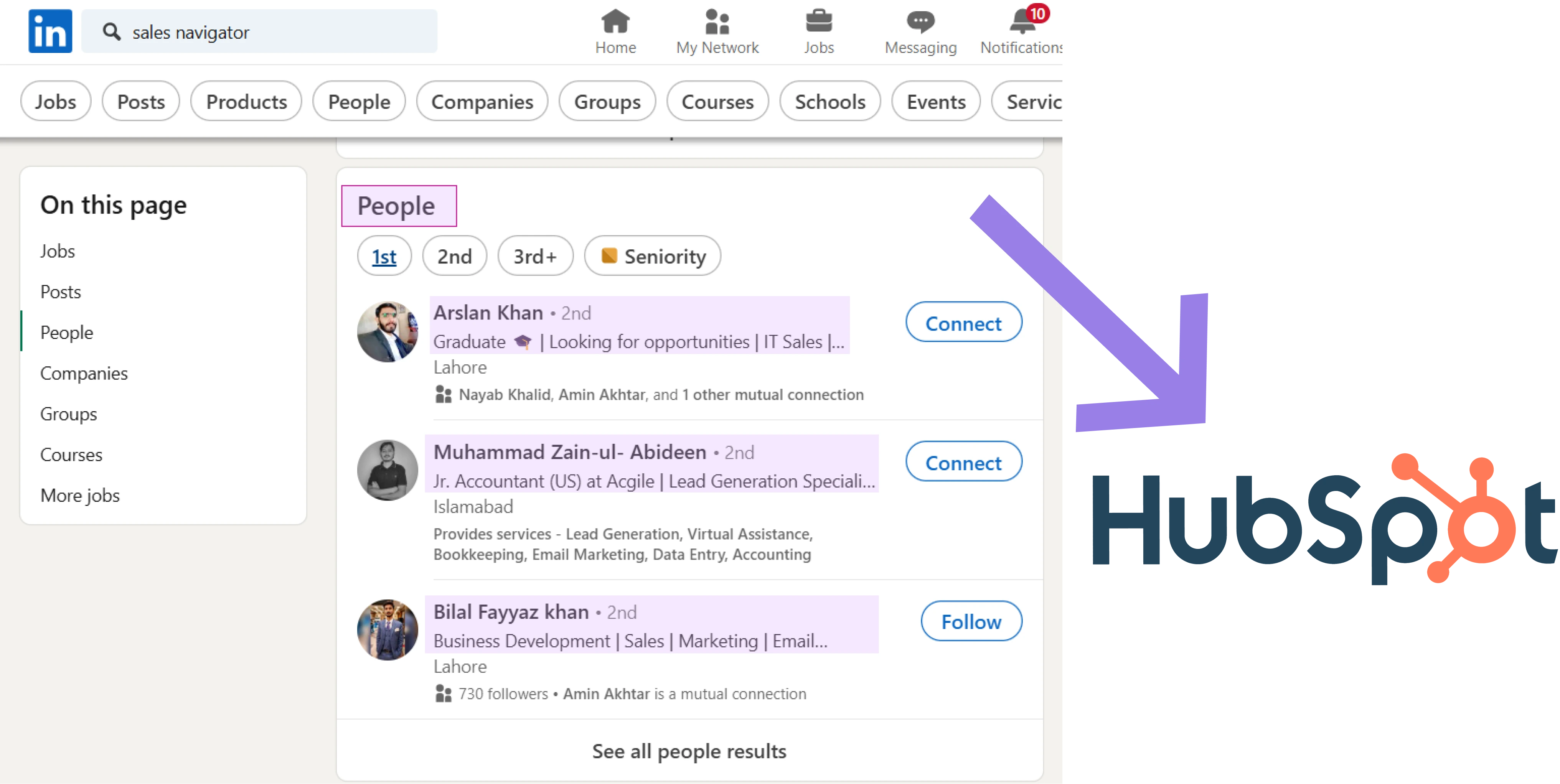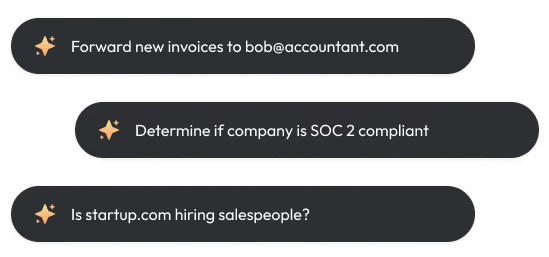To build a sales prospect list, you must gather and analyze data.
To convert prospects into paying customers, you must engage them by contacting them.
Sales prospecting automation tools like Bardeen help you create prospect lists more easily by automatically collecting web data.
Building a great sales prospect list drives growth and revenue. It allows you to identify and focus on the most promising leads and increases your chances of successful conversions through your sales efforts.
You can create a sales list manually, but this approach is exceptionally time-consuming and tedious. Instead, we recommend utilizing AI prospecting tools like Bardeen to optimize your list-building processes.
In this guide, we'll cover sales prospect lists in their entirety. We explore how to build a prospect list, why it benefits you, and how to achieve optimal efficiency during the process. We also highlight some of the best sales tools for prospecting data available. By the end of this article, you'll have a solid understanding of how to automate repetitive tasks and build a high-quality prospect list that will help you achieve your sales goals.
What is a prospect list and why do you need one?
A sales prospect list is a comprehensive collection of potential customers who are likely to benefit from your product or service. It is the start of every successful sales outreach and customer acquisition strategy.
The data contained within a prospecting list usually covers the contact information of company decision-makers. Once you have identified companies that could benefit from your services, you should aim to collect the contact details of those who can authorize purchases.
Understanding the Basics of Sales Prospecting
A sales prospect list serves as the foundation for successful outreach and attracting new customers. Building a well-structured prospect list is crucial for driving growth and revenue in any business.
Here are some key terminologies relating to sales prospect lists that you should understand:
- Prospect: Someone who has been identified as a potential good fit and moved into the sales funnel, regardless of prior interactions with your company.
- Unqualified lead: A sales contact who has expressed interest in your company through actions like registering on your website or interacting with your content.
- Qualified lead: A person who has expressed further interest in your company after additional interactions with a sales agent or company representative.
- Qualification: The process of evaluating leads based on criteria such as budget, authority, need, and timeline to determine their likelihood to convert.
- Conversion: The point at which a prospect becomes a paying customer.
Maximize your sales team's productivity with Bardeen. Download the app now and turn these methods into automated workflows!
Why build a sales prospecting list?
Building a sales prospecting list is crucial for enhancing your sales strategies and improving conversion rates. By creating a targeted list of potential customers, you can focus your efforts on leads that are most likely to convert, resulting in a more efficient and effective sales process.
And here are some key benefits of sales prospecting automation:
- Increased efficiency in targeting the right audience.
- Higher conversion rates due to focused efforts on qualified leads.
- Better resource allocation and time management for sales teams.
- Improved customer acquisition and revenue growth.
Well-structured sales prospect lists allow you to prioritize high-quality leads, personalize your outreach, and build stronger relationships with potential customers. You can also gather data from sources like Crunchbase to gain valuable insights about your target audience and tailor your approach accordingly.
Additionally, building your own prospecting list ensures you have control over the quality and relevance of the leads you pursue. This helps you avoid wasting time on unqualified or uninterested prospects, ultimately leading to a more streamlined and successful sales process.
How to build a prospect list for your business
To build a thorough prospect list, you must first collect data. Then, you have to sort it and qualify your prospects. Lastly, you can then use your list to convert prospects into paying customers.
Building a sales list sounds simple enough—just gather contact information from relevant decision-makers who could be interested in your services—but it can be daunting to start from scratch. And doing it all manually can be significantly draining. That’s why we recommend using sales prospecting tools to automate processes like data collection and qualification.
We’ll now outline four simple steps to help you build your sales prospecting list.
- Gather your data.
- Organize your prospect list.
- Engage and qualify your prospects.
- Nurture and convert prospects into customers.
This process will help you with building a prospect list for business.
Crafting your prospect list: data gathering and analysis
The first, and arguably most important, step in creating a prospect list is data collection. You need to identify companies and individuals who could be interested in your services or products. You can retrieve this information from:
- Previous interactions with your company
- Paid lead generation services
- LinkedIn searches
- Recruitment databases
You could also think of a pain point that your company solves and consider who might benefit most from your solutions.
Collecting all this data—including names, phone numbers, and email addresses—can be incredibly time-consuming and repetitive to do manually. That’s why you should use web scraping tools like Bardeen to automate certain tasks. For example, you can save all LinkedIn profiles that appear in a search to a single spreadsheet.
Organizing your prospect list for maximum efficiency
Once you’ve gathered your data and created your prospect list, you must analyze, refine, categorize, and prioritize the data within.
To do this, first segment your prospects based on factors such as industry, company size, and job title. Implement scoring models to rank prospects according to their likelihood to convert. This will help you prioritize who to target first.
Lastly, you can utilize predictive analysis techniques to identify patterns and trends that can help you target the most promising leads. Tools like Bardeen's LinkedIn prospecting templates can automatically qualify leads from LinkedIn and save them to a database like Google Sheets, Notion, Airtable, or your favorite CRM, streamlining your data gathering and analysis efforts.
Engaging and qualifying your prospects
Once you've gathered and analyzed your prospect data, it's time to start engaging with them. Craft compelling and personalized emails that resonate with your prospect's pain points and interests. This will increase the likelihood of a response. That said, don’t get disheartened if you don’t hear back—this is all too common in sales prospecting.
Another best practice for the initial phases of prospect engagement is to use social selling techniques on platforms like LinkedIn to build relationships and credibility. If you’re implementing a cold calling approach, use targeted scripts to quickly capture interest and schedule meetings.
As you engage prospects, qualify them effectively to ensure they align with your sales goals. Use the BANT criteria (Budget, Authority, Need, Timeframe) to help you focus on high-quality leads most likely to convert.
Automating lead qualification with tools like Bardeen can scale this process by extracting key data points from emails and enriching profiles, enabling you to prioritize your efforts on the most promising opportunities.
Remember, effective prospect engagement is about building trust and demonstrating value. By tailoring your approach to each individual and consistently providing relevant insights, you'll lay the foundation for strong relationships that ultimately lead to closed deals.
Nurturing and converting prospects into customers
Turning prospects into paying customers requires strategic lead nurturing and relationship-building. Focus on providing value and addressing their specific pain points throughout the sales process with effective strategies like:
- Sharing relevant, educational content that demonstrates your expertise and helps prospects overcome challenges.
- Maintaining consistent, personalized communication through email, phone, and social media to stay relevant.
- Automating lead nurturing tasks, such as transferring LinkedIn Sales Navigator leads to your CRM, to scale your efforts.
When it's time to close the deal, be prepared with persuasive techniques. Handle common objections with compelling counterpoints that reframe the value of your solution, highlighting successful case studies and ROI data to build trust and credibility. Creating a sense of urgency with time-sensitive offers or emphasizing the cost of inaction also helps prospects become more involved in the sales funnel.
Throughout the process, leverage tools like HubSpot and Salesforce to track interactions, measure progress, and identify opportunities to optimize your approach. By combining strategic nurturing with strong closing tactics, you'll successfully guide more prospects across the finish line to become loyal customers.
3 ways you can use your prospecting list
Now you’ve built and organized your sales prospect list, how do you set it in motion? Here are three ways you can use a sales list to begin comprehensive marketing strategies:
Email marketing
Emailing is a friendly and straightforward approach to cold outreach. With an organized prospect list, you can sort your emails into different categories like industries or pain points, ensuring you send relevant messages to the people who are best suited to your services.
Cold calling
Naturally, cold calling is what many companies choose after gathering vast volumes of contact information. Speaking on the phone is ideal for acquiring fast answers and pitching your services in real time.
Essential tools to streamline your prospecting efforts
To build a high-quality sales prospecting list, you need to identify the right tools and sources for data collection. Some of the best sales tools for prospecting data include:
- CRM systems that store valuable customer data.
- Social media platforms like LinkedIn that provide insights into prospects' professional backgrounds and interests.
- Industry databases that offer comprehensive company and contact information.
- Web scrapers that let you scrape data from LinkedIn and other sites.
The best sales prospecting automation software is affordable and extensive. Many have free trials that allow you to test out the software before you commit to a paid plan. For example, Bardeen offers a free Google Chrome extension that gives you access to a range of automations for free!
Below, we’ve listed some Bardeen playbooks that can help you extract data and export it to the platforms you use. These automations allow you to easily compile comprehensive sales prospect lists in minutes rather than days:
Prospect list templates: start building today
What does a prospect list look like? You should design your list effectively so that it contains all the necessary information while remaining clear and accessible. A prospect list template typically contains all or a combination of the following information:
- Name
- Company
- Job Title
- Industry
- Phone Number
- Email Address
- Priority
- Company Size
- Company Budget
- Email Validity
- Times Contacted
You should design your spreadsheet or CRM to accommodate as much information as possible about each prospect and company. The more details you can gather, the more enriching conversations you’ll have. You’ll be able to better target potential pain points and offer more tailored solutions. Of course, all this leads to increased conversions and revenue.
Key considerations when choosing a sales prospecting tool
You don’t have to do sales prospecting with a piece of software, but it certainly helps. In fact, we advise everyone to choose a prospecting tool to ensure smooth and efficient data collection and qualification.
When evaluating the various prospecting tools for sales out there, you must pick on ethat aligns with your budget and needs. For example, if you only want to create one big prospect list as a one-off sales venture, don’t select an expensive tool. Instead, pick one with a free plan.
Similarly, choose a tool that can provide all the features you require. A tool like Bardeen gives you everything you need in one place, from automatic data collection to lead qualifying to creating personalized emails. This means you won’t have to use multiple tools in one process.
Bardeen is your one-stop AI sales prospecting tool. Create simple workflows using natural language to automate repetitive tasks like scouring LinkedIn profiles for contact information. Book a demo with us today to scale your sales prospecting.

















.svg)
.svg)
.svg)

Social media outreach
Utilizing social media can be hugely beneficial to your marketing efforts. This could include paid ads on social media platforms like Instagram and Facebook to target your identified demographic.